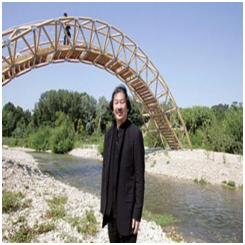You wouldn’t expect cardboard to be strong enough to build a bridge, but that’s exactly what ingenious architect Shigeru Ban decided to use to build a bridge across the Gardon River in his latest work of architectural innovation. You might be familiar with his previous work (his Curtain Wall House, Nomadic Museum, and Paper Church in particular), but the bridge, his latest work, proves that Shigeru Ban is truly a brilliant architectural mind in the world of green and context-sensitive design.
The bridge, located over the Gardon River in southern France, is made almost entirely out of cardboard tubes (281 to be exact), and is strong enough to carry 20 people at a time. The steps of the bridge are constructed from recycled paper and plastic. And how does it stand up, you may ask yourself? It turns out cardboard is surprisingly strong when engineered as precisely and creatively as Ban has designed it, but the foundations do get a little help from wooden boxes packed with sand.
The bridge also sits adjacent to an ancient Roman Bridge, creating an interesting juxtaposition. “It is a very interesting contrast, the Roman stone bridge and the paper bridge. Paper too can be permanent, can be strong and lasting. We need to get rid of these prejudices,” Ban said.
This summer, the surprisingly strong structure — it can withstand the load of at least 20 people — rose triumphantly against the backdrop of the ancient monument. The 72-foot-long frame was made primarily from 281 cardboard tubes — each four and a half inches in diameter and about three-quarters of an inch thick. The tubes were held together by steel joints. For the steps, Ban used a new material called ProFi, assembled from paper and plastic left over from the manufacture of self-adhesive labels. Wooden boxes buried underground and packed with local sand formed the foundations.
Though the bridge resembled a life-size erector set, its diameter and curvature were modeled on the classic proportions of the Pont du Gard’s arch. “It was an interesting contrast,” Ban says. “But it was both a contrast and a harmony.”
The design of the bridge allows for easy assembly and dismantling. It took a team of architecture students only a month to complete the installation, which remained open to the public for six weeks before being dismantled in August before the rainy season. Ban says he expects it to be rebuilt next year.
The main challenge, Ban says, was not mastering the engineering of the bridge but persuading skeptics to rethink basic principles of design. “The strength and durability of a structure hastold this in New York, a day before flying to Abu Dhabi for proposal regarding construction of a house with stuff like sand.



